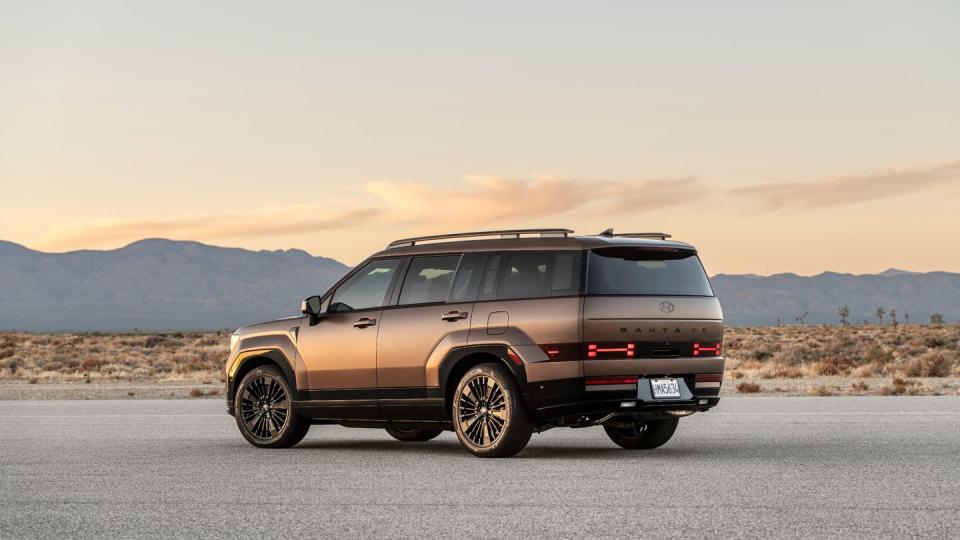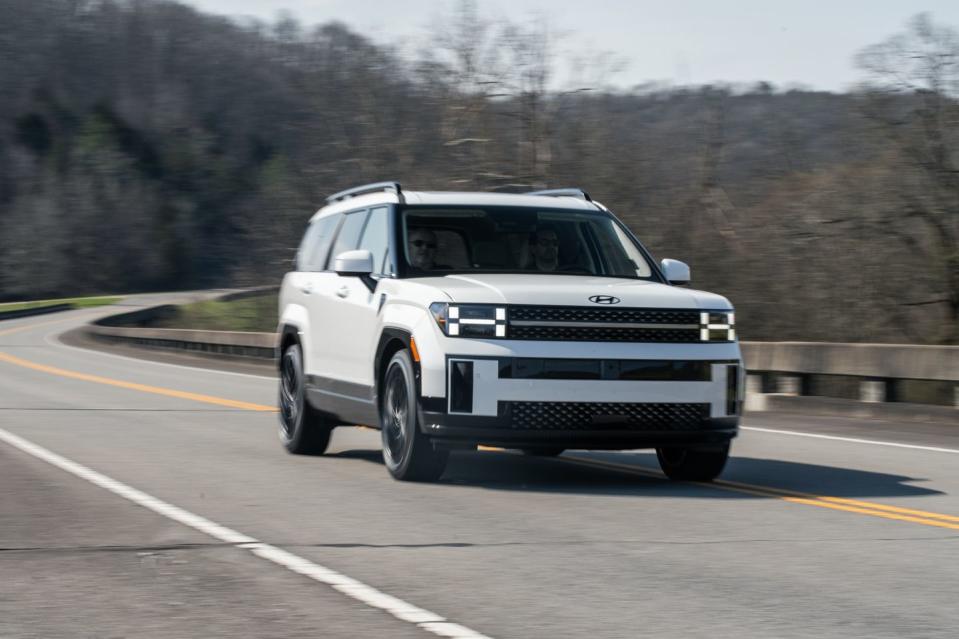2024 Hyundai Santa Fe Is Bigger, Comfy, Awfully Familiar

Hyundai’s newest crossover, now on sale, looks like it came from Land Rover’s new-ish design studio in Warwickshire, UK.
It could be a shrewd move for Hyundai to introduce upscale European SUV styling into this saturated mainstream segment. A hybrid version goes on sale in a few months.
The hybrid starts in SEL FWD trim at $38,345 with destination and caps out at $50,195 for Calligraphy trim and AWD. The non-hybrid Santa Fe SE FWD starts at $35,345 and tops out at Calligraphy AWD for $49,695 with destination.
Midsize crossovers and SUVs represent the most densely populated vehicle segment in America, racking up nearly 4 million sales in 2023—and still growing—and accounting for a quarter of all light-vehicle sales.
It’s easy for any of these thirty vehicles to be overlooked in the haze of cross-shopping and test driving, especially in this sector where utility, flexibility, and practicality trump styling. Years ago, we referred to these as station wagons, and they were great for road trips, with rear-facing third row seats for the little ones.
Unlike steady-eddy brands like Toyota and Honda, Hyundai has decided that predictable, me-too sheetmetal is not going to move the retail needle in the right direction for its latest-generation 2024 Santa Fe, which is now available in showrooms.
Yes, the all-new fifth-generation Santa Fe retains its two-box shape, but this one catches your eye—and not because its form is unique or groundbreaking.
To put it bluntly, Hyundai’s newest crossover looks like it came from Land Rover’s new-ish design studio in Warwickshire, UK. The Santa Fe looks like a mashup of a new Defender with an older Range Rover.
There’s a reason for this. Many of the newer crossovers from mainstream brands (including Hyundai, until now) feature liftgates that are more steeply raked, to make them seem more stylish or even sporty.

But Land Rover’s squared-off proportions (especially the Defender) and a long, flat roof reflect a vehicle that is stretched rearward, allowing for a larger rear cargo hold.
Hyundai wanted this extra room, too, so the new model gains 4.1 cubic feet of cargo space behind the second row, and the liftgate opening is 4.2 cubic feet larger than on the previous model.
The new Santa Fe gains 1.3 inches of ground clearance and is 2.5 inches taller and 1.7 inches longer overall (190.2 inches), with a wheelbase stretched 2 inches to 110.8 inches. Total interior volume has grown a substantial 18.7 cubic feet, and the standard third row with two seats is reasonably comfortable for adults.
Spec changes like these explain why automakers take design risks the way Hyundai has with the Santa Fe. For context, it slots in below the Palisade (both with standard three-row seating, incidentally), which is nearly 7 inches longer, and slots above the Tucson. (Despite its growth, Hyundai tries to position the Santa Fe as a compact SUV. It’s too big for that.)
There’s another reason to scrap the form of the previous Santa Fe, rather than draw inspiration from it: The last one wasn’t selling very well in a booming segment that was up 22% in 2023.
Perhaps this is part of a larger trend to shake up Hyundai design to boost sales. If so, count on substantial changes for the next-generation Sonata, Venue, and Santa Cruz because they’re all lagging their rivals.
It could be a shrewd move for Hyundai to introduce upscale European SUV styling into this saturated mainstream segment. Who wouldn’t want their $35,000 Santa Fe (base price) to be confused with a go-anywhere Land Rover?
But let’s be clear about this: The Santa Fe is built on a front-wheel-drive unibody architecture, so it is not intended for hard-core off-roading, unlike body-on-frame Jeeps like the Wrangler or Gladiator. (Incidentally, all Land Rovers have employed unibody platforms as well, since 2017.)
Most mainstream SUV shoppers aren’t looking to conquer the Rubicon trail (much like Range Rover intenders, come to think of it), so the new Santa Fe should be well suited for everything from the highway to the campground service roads.

If you’re planning something more adventurous, consider getting the Santa Fe XRT trim with more ground clearance and all-terrain tires, available only with all-wheel drive. XRT is right in the middle of the range, well equipped for $41,995 with destination.
During the media drive last week near Nashville, the Santa Fe XRT performed well on a hilly, rocky, off-road trail through the woods. Wheel sizes for the Santa Fe range from 18 to 20 inches.
But the Santa Fe is more than comfortable cruising and in city and suburban driving. Our topline Calligraphy trim tester tipped the scales at under 4500 pounds, and the vehicle overall felt more agile than expected from a three-row ute. Despite its upright stance, there’s very little wind noise from the side mirrors or A-pillars.
For now, there’s just one available powertrain: a 2.5-liter turbocharged four-cylinder with both direct fuel injection and conventional port injection. The 277 hp and 311 lb-ft of torque are routed through an eight-speed wet dual-clutch transmission that manages smooth, barely noticeable shifts.
You probably want a six-cylinder engine, but I-4s are becoming the norm here and I never sensed that the vehicle size was too much for the powertrain. It could pass with confidence on two-lane roads and without upsetting the transmission.
A hybrid powertrain will be available in the Santa Fe in a few months, relying on a 178-hp 1.6-liter direct-injected four-cylinder paired to a six-speed automatic. Combined with an electric motor and lithium-ion battery, the Santa Fe Hybrid is rated at a combined 231 hp and 271 lb-ft of torque.
Those numbers are a big step down from the 2.5-liter non-hybrid, but the fuel economy gains with the hybrid are compelling: 35/34 mpg city/highway with AWD, compared to 20/28 mpg with AWD for the non-hybrid.
We didn’t get to drive the hybrid, but it will likely feel less motivated. Pricing between the two fall roughly in line. The hybrid starts in SEL FWD trim at $38,345 with destination and caps out at $50,195 for Calligraphy trim and AWD. The non-hybrid Santa Fe SE FWD starts at $35,345 and tops out at Calligraphy AWD for $49,695 with destination.
Inside, Hyundai executed a fine, ergonomic interior with premium materials (microsuede headliner, Nappa leather), high tech (biometric security fingerprint sensor), and clever features (a center console that opens both directions for access from first and second rows).
At least that was true for our Calligraphy tester that stickered for $50,905, including $1000 for the Earthy Brass Matte paint job that is car-wash safe, we are told. Headroom is plentiful, even in the usually cramped third row.
With that high roof, Hyundai sees customers folding the seats flat and lounging, napping, or reading while facing backward, enjoying the view through the large liftgate opening. Tailgate!
This vehicle was designed during a pandemic, so there’s a sterilization tray above the glovebox for placing your keys, phone, gloves, and wallet to zap with cleansing ultraviolet rays. The dual wireless smartphone charging in the center console is pretty handy, too.
The usual driver-assistance technologies are onboard, including navigation-based smart cruise control, but there isn’t a hands-free, pedal-free highway driving mode like General Motors offers with Super Cruise. You can, however, stand outside your Santa Fe and use the fob to pull out of a tight parking space, courtesy of optional Remote Smart Parking Assist.
It’s odd that Hyundai identifies the three-row Santa Fe’s rivals as smaller crossovers with only two rows: Honda Passport, Subaru Outback, and Chevrolet Blazer.
Instead, the Santa Fe is more likely to be cross-shopped with the similarly priced Toyota Highlander, Mazda CX-90, VW Atlas, Nissan Pathfinder, and Honda Pilot, although these three-row models are longer overall.
Perhaps this is part of Hyundai’s strategy: to use the Santa Fe’s unique shape to join the Palisade in competing for three-row shoppers.
Do you like the styling of the new Hyundai Santa Fe? Is it on your shopping list? Please comment below.

 Yahoo Autos
Yahoo Autos 